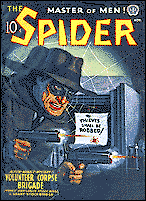
The Bloody Pulps
(a small portion of a longer, comprehensive piece by Jim Steranko,
from his History of Comics, Volume 1)
The nation was in the mood for swift justice!
It was an era of crime, of Dillinger, Bonnie and Clyde, Pretty Boy Floyd.
Crime was front page news. There were crimes of passion, crimes of revenge,
crimes for gain, crimes for kicks.
The movies countered with their own brand of violence, with Bogart, Garfield,
Greenstreet, Cagney and Edward G. Robinson. And bullet for bullet, the pulps
matched them all.
Time the pulps |
 Pulps were untrimmed magazines named for the soft paper flecked with shreds
of wood fibre on which they were printed. Publishers used pulp paper because
there was nothing cheaper available. Pulps had little to do with quality!
The key word was quantity! Publishers became successful by relentlessly
asking themselves this question: How can I print more books, more often,
more cheaply?
Pulps were untrimmed magazines named for the soft paper flecked with shreds
of wood fibre on which they were printed. Publishers used pulp paper because
there was nothing cheaper available. Pulps had little to do with quality!
The key word was quantity! Publishers became successful by relentlessly
asking themselves this question: How can I print more books, more often,
more cheaply?